So you think you're ready for your summer road trip. Hot, humid and rainy summers can be hard on vehicles, particularly on the paint, tires, windshield wipers and interior. Even the newest vehicles needs to be looked at before taking to the road for any extended amount of time. In fact, all cars and trucks need a good summer check-up. Like maintaining your own health, prevention and early diagnosis are the key to keeping your vehicle on the road.
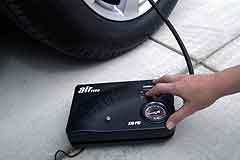
Tires:
Check tires not only for proper inflation, but also for uneven wear, bald patches and bulges. Bulges mean it's time for new tires, and uneven wear usually indicates that the alignment is off. With gas prices so high, make sure the tires are inflated to the proper PSI, or risk losing fuel efficiency. And weak parts of tires will only deteriorate faster in the sun and heat. So before hitting the road, make sure you're riding on the best, and newest, possible tire you can afford.
Battery:
Excessive heat can cause battery fluid evaporation, which shortens the life of the battery and damages the internal structure of the device. Check the voltage regulator, because a malfunction there can allow the charging rate of the battery to increase, also shortening its lifespan. Keeping the top of the battery and the ports clean is paramount - dirt is a conductor which robs the battery of life, too.
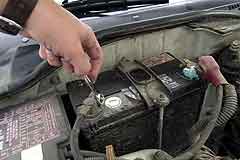
If the battery is one that needs topping off, check it regularly and refill only with distilled water. Corrosion (a white crust) on the ports also inhibits battery life, so clean it immediately. It will only make it more difficult for the battery to start the car if left on.
Cleaning a battery is relatively simple: take one to two tablespoons of baking soda and stir into two cups of water to make a paste. Apply the paste to the disconnected battery with an old toothbrush, scrubbing off the corrosion. Wipe it clean and dry the area well before reconnecting the cables. If the battery has removable cell caps, be sure to keep the baking soda mixture far away from them.
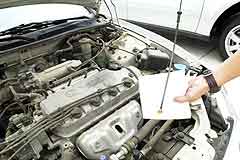
Fluids:
Check the transmission fluid after the car is warmed up - it's best after a few miles of driving. The fluid should be between the marks on the dip stick, and should be either light red or gold in color.
The brake fluid reservoir is located on top of the brake master cylinder. There are usually indicators such as "max" and "min" or "fill line," and a quick glance should tell if it's adequately filled.
Motor oil needs to be checked when the engine is cool - pull out the dip stick, wipe it clean, then plunge it back into the hole. There are lines or holes on the end of the stick, and if the oil line is in between those marks, the oil level is fine, unless the color is dark like Guinness beer; then it is time for a change. If it's an amber-honey color, it’s still good for a while longer.
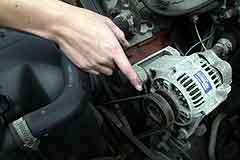
Belts and Hoses:
Also important to check before a road trip are the belts and hoses. Look for cracks, swollen or collapsed areas on the hoses as well as spots that are soft, sticky, crunchy or oil-soaked. Any of those signs indicate that the belt or hose needs to be replaced. Weak hoses break under pressure which increases in hot weather. A broken hose is one of the major causes of over heating, and breakdowns. Healthy belts shouldn't show any signs of fraying or cracking, and there should be no little chips out of them.
Listen to the engine with the radio off and the windows rolled down. Squealing noises as the engine accelerates, or slow, rhythmic slapping sounds when the car idles, indicate belt problems.
Drive belts:Drive belts are a vital part of the car. They are driven by the engine and help operate the alternator, water pump, power steering pump, air conditioning and compressor. Drive belt problems can cause a variety malfunctions from overheating, to charging system failure.
Lots of problems come from worn belts or those with incorrect tension. Check the owner's manual for the location of these belts and be sure that they aren't cracked or glazed over and are free of frayed edges.
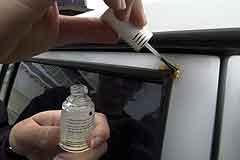 Paint:
Paint:Scan your vehicle for any scratches, and cover them with touch-up paint. This can be found for almost every vehicle on the road in auto parts stores, or online for paint jobs using less common paints. If there's no time, a coat of clear nail polish will do. Rust is a car's worst enemy, so keep exposed metal from getting air at all costs.
Interior:
You'd also do well to use an interior surface protectant throughout the car. This is like anti-wrinkle cream for the car’s leather, and synthetic surfaces. The earlier and more often these products are used, the longer the dash will look like new, and less cracks and crow's feet will begin to appear in the interior.
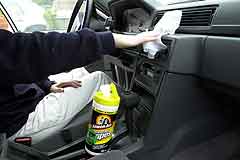
Lighting:
Obviously, check the headlights, taillights, reverse lights and signaling lights for problems - at least once every few months. Hundreds of accidents every year occur from faulty lighting, and remember, prevention is key.
Cabin air filter:Changing the cabin air filter is just as important for the car as it is for you and your lungs. Especially after this year's rainy winter season, musty odors coming out of the air conditioning vents are a sign that the filter is overdue for a change. In fact, the longer you wait to change that filter, the worse the air quality will become. It can even be worse than breathing the outside air. And changing that filter is not just good for you, it's good for the car. An older filter allows outside contaminants to build up, and eventually causes corrosion in the air conditioning and heating systems - something definitely to avoid.
A dirty filter also means less vehicle efficiency. If you find that the air volume is lower, or the vehicle doesn’t cool as well as it used to, a dirty filter can be the culprit. Any time the vehicle has to work harder to do the same task, fuel efficiency will decrease the engine has to work harder than necessary, decreasing its life.
Neglected maintenance causes 2,600 deaths and 100,00 injuries every year. That totals over $2 billion in lost wages, medical expenses and property damage. Remember, when in doubt, take your vehicle to the shop. Tell the mechanic what type of driving you typically do, and if you're planning a road trip. That way your mechanic can be sure to check everything and tune the necessary components.




